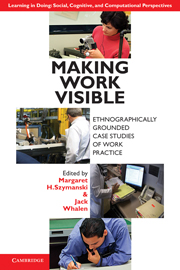Book contents
- Frontmatter
- Contents
- List of Figures and Excerpts
- List of Tables
- List of Contributors
- Series Foreword
- Foreword by John Seely Brown
- Acknowledgments
- Introduction
- Part I Work Practice Study in Historical Context
- Part II Applying Work Practice Methods
- Part III Practices around Documents
- Part IV The Customer Front
- 10 Integrated Customer Service
- 11 Interactions at a Reprographics Store
- 12 Ethnographically Informed Technology for Remote Help-giving
- 13 Sign of the Times at the Department Store
- Part V Learning and Knowledge Sharing
- Part VI Competency Transfer
- References
- Index
- LEARNING IN DOING: SOCIAL, COGNITIVE AND COMPUTATIONAL PERSPECTIVES
13 - Sign of the Times at the Department Store
Replacing Paper with Electronic Signs
Published online by Cambridge University Press: 05 August 2012
- Frontmatter
- Contents
- List of Figures and Excerpts
- List of Tables
- List of Contributors
- Series Foreword
- Foreword by John Seely Brown
- Acknowledgments
- Introduction
- Part I Work Practice Study in Historical Context
- Part II Applying Work Practice Methods
- Part III Practices around Documents
- Part IV The Customer Front
- 10 Integrated Customer Service
- 11 Interactions at a Reprographics Store
- 12 Ethnographically Informed Technology for Remote Help-giving
- 13 Sign of the Times at the Department Store
- Part V Learning and Knowledge Sharing
- Part VI Competency Transfer
- References
- Index
- LEARNING IN DOING: SOCIAL, COGNITIVE AND COMPUTATIONAL PERSPECTIVES
Summary
Towards the end of the 1990s, Xerox Palo Alto Research Center (PARC) spun out an invention called Gyricon in the hopes of commercializing it. Gyricon, a kind of electronic reusable paper, is a static display consisting of thousands of tiny magnetic balls suspended in a thin layer of oil sandwiched between two layers of a clear substrate containing a thin wire grid (see Figure 13.1). The balls are half white and half black, and their orientation can be changed by a magnetic field induced by applying a small electric current to the wire grid. One of the major benefits of the invention is that, once changed, the balls remain in the same orientation and hence the display maintains the same image without needing continuous power. The new company, named Gyricon Media Inc., was to produce signs in various shapes and sizes, targeting conference venues, hotels, and other public places where information such as event announcements and directions can vary from day to day.
Business Services, exploring possibilities for creating solutions and services around the new display technology, approached a major department store chain with the objective to replace the traditional paper signs in the stores with Gyricon signs. The department store chain consisted of a flagship store close to company headquarters, and scores of large-, medium-, and low-volume stores distributed throughout the Eastern United States.
- Type
- Chapter
- Information
- Making Work VisibleEthnographically Grounded Case Studies of Work Practice, pp. 240 - 254Publisher: Cambridge University PressPrint publication year: 2011



